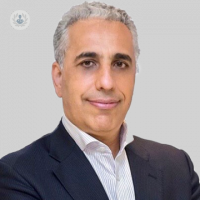Fibroadenomas (breast mouse): how to treat them
Written in association with:Fibroadenomas, otherwise known as breast mouse are very common. Approximately 10% of women have one of these breast lumps, often without even knowing.

Fibroadenomas often appear in women between the ages of 15 and 35, or during pregnancy and breastfeeding. We spoke to leading oncoplastic breast surgeon, Professor Kefah Mokbel, to learn what causes this condition, how it can be managed and the best time to have a follow-up appointment.
What is a fibroadenoma?
A fibroadenoma usually appears as a firm, well-defined lump in the breast. They can often move around, which is why the term breast ‘mouse’ is often used to refer to them.
These benign lumps represent an alteration in the normal development of the breast and are dependent on the sex hormone oestrogen.
Fibroadenomas can occur as multiple lumps, single lumps and can even occur in both breasts. They can grow very quickly, especially in adolescent girls, and if they reach a size greater than 5 cm in diameter they are known as giant fibroadenomas.
What causes fibroadenoma?
Whilst the precise cause of this condition has yet to be determined, fibroadenomas are known to be hormone responsive, stimulated by oestrogen, progesterone and lactation, and frequently regress after the menopause. Furthermore, they are more common in young women of Afro-Caribbean origin and can run in families.
Despite their characteristic features on examination, some are difficult to distinguish from other breast masses on clinical grounds alone and for this reason, patients should be referred for specialist evaluation.
How is fibroadenoma found?
Investigations
- Breast ultrasound scan (for all patients)
In this patient demographic, ultrasonography is usually the imaging modality of choice and sufficient to provide reassurance. Simple fibroadenomas appear as solid well-circumscribed masses, typically round / oval, with smooth partially lobulated margins.
- 3D mammography is undertaken in women aged > or = 35 years.
- Core needle biopsy is undertaken routinely in women older than 20 years in order to confirm the diagnosis.It should be also considered in younger women where the ultrasound is equivocal or the mass is larger than 3cm. Giant fibroadenomas (>5cm) are more common in pregnant or lactating women. In such cases, it is essential to differentiate fibroadenomas from phyllodes tumours, which tend to occur at an older age and are malignant in approximately 10% of cases.
How are fibroadenomas managed?
Three tests are often carried out to confirm the diagnosis of fibroadenoma:
- physical examination
- ultrasound scan and/or mammogram
- needle biopsy
If fibroadenomas are found, you will need to decide what to do next. Studies have shown that one in four fibroadenomas disappear or shrink completely within two years of diagnosis. In one in two cases, it stays the same size, and only around 25 in every 100 actually get bigger.
- Women with simple fibroadenomas should be reassured that these lesions are not cancerous and malignant transformation is exceptional, with a negligible incidence of 0.002%. For the majority of cases, particularly young women (under 30) with fibroadenomas, confirmation of the diagnosis and reassurance are all that is necessary.
- Surgical excision should be reserved only for cases where a definitive diagnosis could not be established, large lesions (> 3 cm) or those which are increasing in size. Surgical excision of fibroadenomas is usually performed through an aesthetically placed incision around the nipple. Vacuum-assisted removal through a wide bore needle under local anaesthesia using ultrasound guidance through a 3 mm incision (keyhole removal) is a valid alternative to open surgical excision in most cases.
- It is reasonable to consider surgical removal in women with a strong family history.
When should a follow-up appointment take place?
A follow-up ultrasound scan after six months is useful in providing reassurance and determining whether the fibroadenoma is increasing in size.
For a breast screening or for more information on breast surgery, you may like to book an appointment with a leading oncoplastic breast surgeon such as Professor Kefah Mokbel. Visit his Top Doctors profile today for more information.


